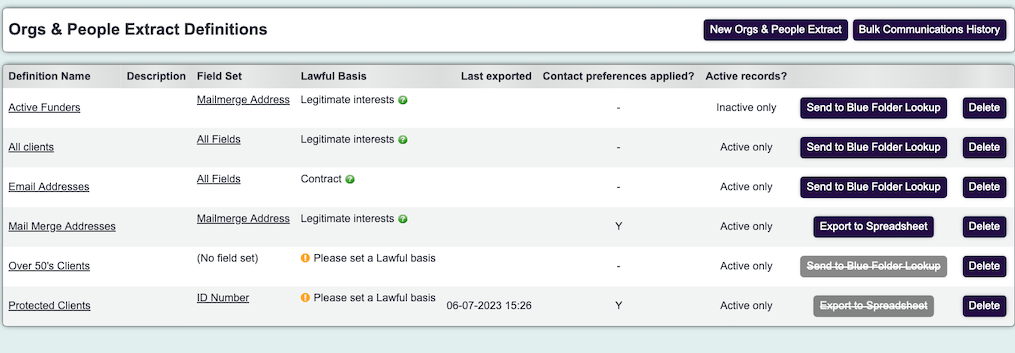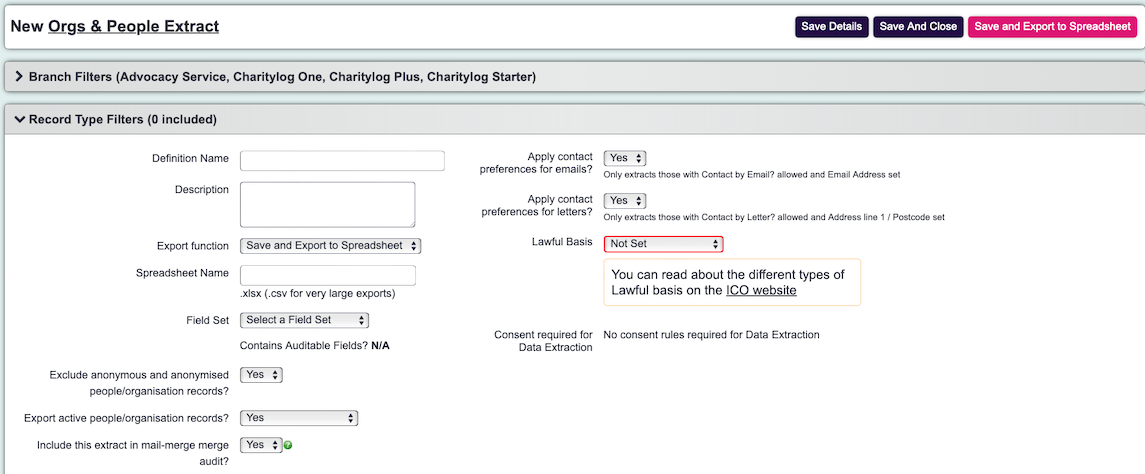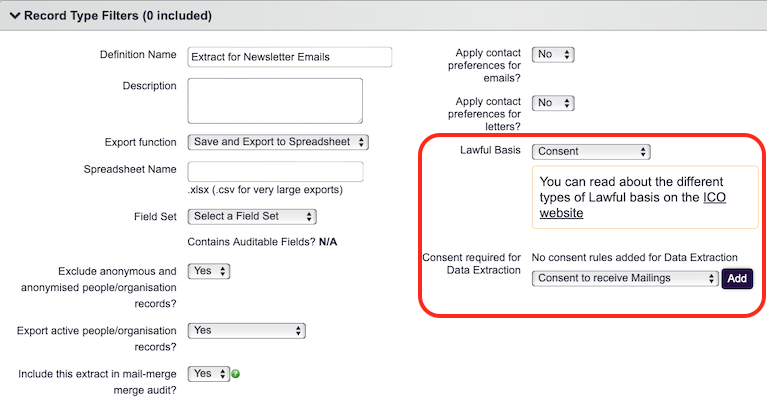Difference between revisions of "Orgs & People Extract"
(→Introduction) |
Alanconway (talk | contribs) (→Introduction) |
||
| (23 intermediate revisions by 2 users not shown) | |||
| Line 9: | Line 9: | ||
1) Directly from the Contact Management menu, for exporting people regardless of the kind of work you've done with them. | 1) Directly from the Contact Management menu, for exporting people regardless of the kind of work you've done with them. | ||
| − | 2) Via a blue folder in a report, for instance to extract everyone who's had a contact in a particular project. | + | 2) Via a [https://wiki.dizions.co.uk/index.php/Blue_Folder_Lookup blue folder] in a report, for instance to extract everyone who's had a contact in a particular project. |
| + | |||
| + | For saved Extracts, you must set a set a Lawful basis for this to function. The June 2024 version made specifying a [https://ico.org.uk/for-organisations/uk-gdpr-guidance-and-resources/lawful-basis/a-guide-to-lawful-basis/ lawful basis] compulsory for using this feature. An audit of the basis, e.g. consent or legitimate interests, may be logged against each person whose details are extracted. | ||
| + | |||
| + | The below video gives an overview of how they can be used. | ||
| + | |||
| + | {{#ev:youtube|VskxjTHNY4Y|790}} | ||
| + | |||
| + | =Running an Extract= | ||
| + | |||
| + | To run an existing extract, ensure the Lawful basis has been selected, then choose from either ''Send to Blue Folder'' or ''Extract to Spreadsheet''. You can always click on an extract to check or edit the options. | ||
| + | |||
| + | [[File:neworgextract.png]] | ||
=Creating a Orgs & People Extract= | =Creating a Orgs & People Extract= | ||
| Line 15: | Line 27: | ||
To edit an existing definition, click on the name on the left or to create a new one click the 'Create New Orgs & People Extract' button. On the following screen you will be able to configure: | To edit an existing definition, click on the name on the left or to create a new one click the 'Create New Orgs & People Extract' button. On the following screen you will be able to configure: | ||
| − | == | + | ==Branch Reporting Section (requires [[Modules| Branch Module]])== |
| − | + | In this section you can specify to report on records in; | |
| + | *All Branches | ||
| + | *Selected Branches | ||
| + | *Selected Branch Groups (views) | ||
| − | + | ==Report Type Filters== | |
| − | == | + | [[File:organdpeopleextract.png]] |
| + | |||
| + | * '''Definition Name''' - If you are saving the extract it would make sense to give it a specific name so you can easily distinguish it from the others. | ||
| + | * '''Description''' -optional, but allows you to add a detailed description of the filters etc. | ||
| + | * '''Export Function''' - You can either send to [https://wiki.dizions.co.uk/index.php/Blue_Badge_Holder Blue Folder Look up] for additional options, or extract direct to Spreadsheet | ||
| + | * '''Spreadsheet Name''' - if you are exporting to spreadsheet, you can preset the name | ||
| + | * '''Field Set''' - This allows you to choose which [https://wiki.dizions.co.uk/index.php/Field_Sets fields] will be included in the extract. Note you must set up the field set first. | ||
| + | * '''Exclude anonymous and anonymised people/organisation records''' - will be set to Yes as a default. You could choose to include anonymous records for the extract. | ||
| + | * '''Export active people/organisation records''' - Will default to Yes, but you could decide to export inactive records also. | ||
| + | * '''Include this extract in mail-merge merge audit?''' - will default to Yes. but you could opt to not include in the mail merge audit. Especially if this extract is for reporting purposes and not mail merge. | ||
| + | * '''Apply contact preferences for emails?''' - | ||
| + | * '''Apply contact preferences for letters?''' - | ||
| + | * '''Lawful Basis''' - You will be required to specify the basis by which this extract is being run. You will need to choose from one of the following: Consent, Contract, Legal Obligation, Legitimate Interests, Public Task, Vital Interests. Lawful basis still needs to be applied as the extract may be used for mail merge and/or other communication systems. | ||
| + | |||
| + | ==Consent Based Extracts== | ||
| + | |||
| + | If you choose ''Consent'' as the lawful basis, you will see the below option. You will then be required to specify which consent rule should apply. This means it will only extract records where there is a valid response to that consent rule. It will also ignore records where that [https://wiki.dizions.co.uk/index.php/Consent_Rules consent] has expired. | ||
| + | |||
| + | [[File:consentbasedextract.png]] | ||
| + | |||
| + | ==Who to Include/Exclude== | ||
[[File:Mail_Merge_Orgs_Types.png|1050px]] | [[File:Mail_Merge_Orgs_Types.png|1050px]] | ||
| Line 33: | Line 68: | ||
You wish to send a mail out to staff and a second mail out to volunteers. You do not want to send anyone two mail outs. The staff mail out is only set to include staff, the second mail out would be set to include volunteers and exclude staff. Anyone that is both a staff member and volunteer would only be included in the staff mail out. | You wish to send a mail out to staff and a second mail out to volunteers. You do not want to send anyone two mail outs. The staff mail out is only set to include staff, the second mail out would be set to include volunteers and exclude staff. Anyone that is both a staff member and volunteer would only be included in the staff mail out. | ||
| − | == | + | ==Organisation & People Filters== |
'''Note: The Orgs & People Extract excludes deceased people by default. | '''Note: The Orgs & People Extract excludes deceased people by default. | ||
| Line 73: | Line 108: | ||
Once you have created a line you can add a new line by clicking the 'Save Details' button. If you wish to remove a line then set the 'Field Name' to '(No Field Selected)', when saving the line will be deleted. Once you have finished specifying the criteria click on the 'Save and Close' Button. | Once you have created a line you can add a new line by clicking the 'Save Details' button. If you wish to remove a line then set the 'Field Name' to '(No Field Selected)', when saving the line will be deleted. Once you have finished specifying the criteria click on the 'Save and Close' Button. | ||
| − | |||
| − | |||
| − | |||
| − | |||
| − | |||
| − | |||
| − | |||
| − | |||
| − | |||
| − | |||
| − | |||
=Existing Definitions= | =Existing Definitions= | ||
Latest revision as of 11:50, 3 September 2024
Contents
Introduction
The Orgs & People Extract function is used to create definitions for reporting or as a data source for mail merging in another application, e.g. Microsoft Excel/Word. They can be used in 2 ways:
1) Directly from the Contact Management menu, for exporting people regardless of the kind of work you've done with them.
2) Via a blue folder in a report, for instance to extract everyone who's had a contact in a particular project.
For saved Extracts, you must set a set a Lawful basis for this to function. The June 2024 version made specifying a lawful basis compulsory for using this feature. An audit of the basis, e.g. consent or legitimate interests, may be logged against each person whose details are extracted.
The below video gives an overview of how they can be used.
Running an Extract
To run an existing extract, ensure the Lawful basis has been selected, then choose from either Send to Blue Folder or Extract to Spreadsheet. You can always click on an extract to check or edit the options.
Creating a Orgs & People Extract
To edit an existing definition, click on the name on the left or to create a new one click the 'Create New Orgs & People Extract' button. On the following screen you will be able to configure:
Branch Reporting Section (requires Branch Module)
In this section you can specify to report on records in;
- All Branches
- Selected Branches
- Selected Branch Groups (views)
Report Type Filters
- Definition Name - If you are saving the extract it would make sense to give it a specific name so you can easily distinguish it from the others.
- Description -optional, but allows you to add a detailed description of the filters etc.
- Export Function - You can either send to Blue Folder Look up for additional options, or extract direct to Spreadsheet
- Spreadsheet Name - if you are exporting to spreadsheet, you can preset the name
- Field Set - This allows you to choose which fields will be included in the extract. Note you must set up the field set first.
- Exclude anonymous and anonymised people/organisation records - will be set to Yes as a default. You could choose to include anonymous records for the extract.
- Export active people/organisation records - Will default to Yes, but you could decide to export inactive records also.
- Include this extract in mail-merge merge audit? - will default to Yes. but you could opt to not include in the mail merge audit. Especially if this extract is for reporting purposes and not mail merge.
- Apply contact preferences for emails? -
- Apply contact preferences for letters? -
- Lawful Basis - You will be required to specify the basis by which this extract is being run. You will need to choose from one of the following: Consent, Contract, Legal Obligation, Legitimate Interests, Public Task, Vital Interests. Lawful basis still needs to be applied as the extract may be used for mail merge and/or other communication systems.
Consent Based Extracts
If you choose Consent as the lawful basis, you will see the below option. You will then be required to specify which consent rule should apply. This means it will only extract records where there is a valid response to that consent rule. It will also ignore records where that consent has expired.
Who to Include/Exclude
In this section you will find the list of People and Organisation types you are using on your system. The names displayed are the ones specified in Customise Orgs & People. For each record type you can choose one of the following options:
- Who to Include - This will include this record type when running the definition.
- Who to Exclude - This is to exclude a record type when running the definition. If a person/organisation is set to more than one record type, the exclude will not use this record for the include.
Example You wish to send a mail out to staff and a second mail out to volunteers. You do not want to send anyone two mail outs. The staff mail out is only set to include staff, the second mail out would be set to include volunteers and exclude staff. Anyone that is both a staff member and volunteer would only be included in the staff mail out.
Organisation & People Filters
Note: The Orgs & People Extract excludes deceased people by default.
If you require to report on deceased clients, you will need to specify this using the Extra Criteria to set "Deceased = Y OR Deceased = N"
The extra criteria section allows you to add conditions (arguments/queries) to the records being exported. These arguments/queries can include items, such as "only people in a certain location or a certain client type based on demographic data". This section will display the number of arguments/queries setup in the criteria.
To add or edit the criteria click on the 'Add Extra Criteria' button.
The criteria page will always start with a line with the condition set to 'WHERE'.
- Condition - The first condition will always be set to where, this is the start of the argument/query. You can add multiple lines to the argument/query using the following conditions:
- AND - This is in addition to the first line. The system will find data based on the first line and the second line.
- OR - This will look at the first line to match data or match data based on the second line.
Example for AND Looking for people in specific town that have any disability. Where 'Town' = 'Town Name' AND 'Has Disability' = 'Yes' Example for OR Looking for people in two postcode areas, L1 and L2. Where 'Postcode' text begins with 'L1 ' or 'Postcode' text begins with 'L2 '
- Field Name - This is a dropdown list of people/org fields that can be used. If you select a field that is populated from a drop down menu you will be display a selection screen where you can select the required values (will imply 'or' for each option), this will populate the 'Selection Value' for you when you click the 'Save Details' button on the pop up screen.
- Selection Criteria - This is specify the argument/query that is to be used on that line:
- Equals (=) - The data in the selected field must equal the 'Selection Value'
- Not Equals (<>) - The data in the selected field must not equal the 'Selection Value'
- Greater Than (>) - The data in the selected field must be greater than the 'Selection Value', which would be appropriate for values and dates.
- Greater Than or Equal To (>=) - The data in the selected field must be greater than or equal to the 'Selection Value', which would be appropriate for values and dates.
- Less Than (<) - The data in the selected field must be less than the 'Selection Value', which would be appropriate for values and dates.
- Less Than or Equal To (<=) - The data in the selected field must be less than or equal to the 'Selection Value', which would be appropriate for values and dates.
- Text Begins With - The data in the selected field must begin with the 'Selection Value', often used with text (postcodes, address line or notes).
- Text Contains - The data in the selected field must contain the 'Selection Value', often used with text (postcodes, address line, notes or email address).
- Text Does Not Contain - The data in the selected field must not contain the 'Selection Value', often used with text (postcodes, address line, notes).
- IN (this,this,this) - a set of any required values, separated by commas, for example, Smith,Jones,Williams would find everyone whose surname was any one of these three.
- Selection Value - Where you enter the values to be used in the argument/query. This may have been auto completed by the selection of the 'Field Name', which you can change by clicking the 'Change Selection' button.
Once you have created a line you can add a new line by clicking the 'Save Details' button. If you wish to remove a line then set the 'Field Name' to '(No Field Selected)', when saving the line will be deleted. Once you have finished specifying the criteria click on the 'Save and Close' Button.
Existing Definitions
To edit click on the name of the definition you wish to change.
To change a Field Set linked to the definition (export to spreadsheet only) click on the name of the displayed Field Set.
To run an existing definition click on the button on the right hand side:
- Export to Spreadsheet
- Send to Blue Folder Lookup
Orgs & People Extract for Assessment Documents
It is also possible to use Microsoft Orgs & People Extract to create assessment documents. The following video explains how this can be done.






